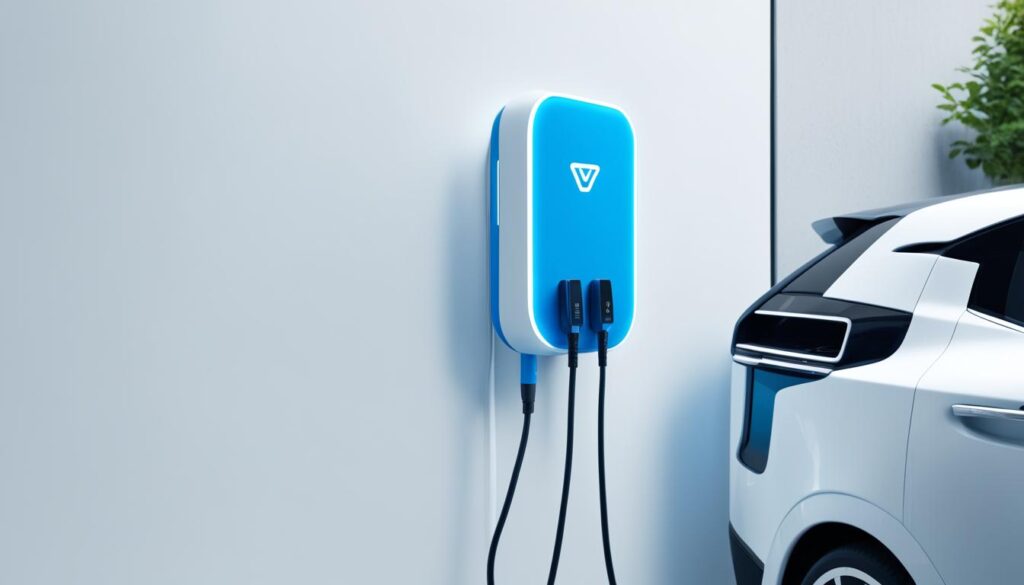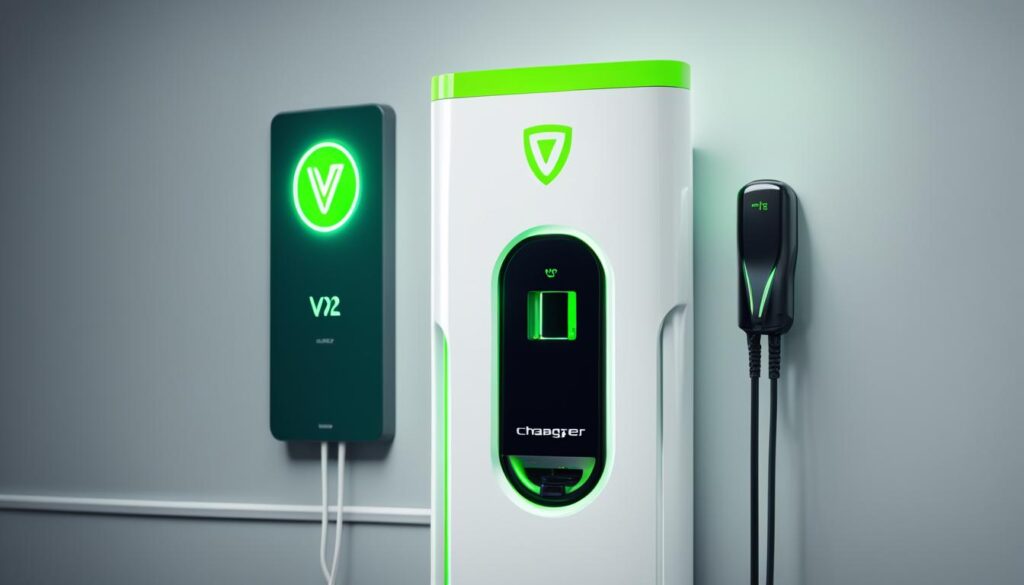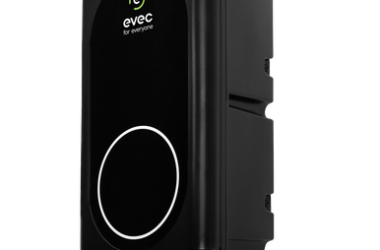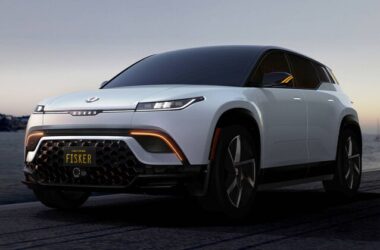As electric vehicles (EVs) become increasingly popular, the need for efficient charging solutions is on the rise. One exciting technology that is gaining traction is bi-directional charging, also known as vehicle-to-home (V2H) charging. With V2H chargers, EV owners can utilize their vehicles to power their homes, creating a sustainable and cost-effective charging solution.
V2H chargers are compatible with EVs that have bidirectional charging capabilities. These chargers allow the transfer of energy from the EV’s battery back to the home, enabling homeowners to store excess solar energy or take advantage of cheap off-peak electricity. By leveraging their EVs as energy storage systems, users can reduce household electricity costs and promote a more sustainable lifestyle.
Key Takeaways:
- V2H chargers enable the transfer of energy from EVs back to the home.
- They can be used to store excess solar energy or take advantage of cheap off-peak electricity.
- V2H charging reduces household electricity costs.
- These chargers have the potential to provide backup power during blackouts or emergencies.
- By utilizing V2H charging, EV owners can contribute to a more sustainable lifestyle.
How Does V2H Charging Work?
V2H chargers rely on the bi-directional charging capabilities of electric vehicles (EVs) to enable the transfer of energy from the vehicle back to the home. This innovative technology offers a sustainable and efficient charging solution, allowing EV owners to optimize the use of their vehicles’ batteries.
To make use of V2H charging, both the EV’s onboard system and the EV charger need to support bidirectional charging. This means that the EV’s battery can both receive energy from the grid for charging purposes and send energy back to the grid or home for power supply.
The key component of a V2H charger is the DC to AC converter. This converter transforms the DC (direct current) energy stored in the EV’s battery into AC (alternating current), which is the type of electricity used in homes and buildings. The converted energy is then safely transferred back to the home for various applications.
Once the energy is converted to AC, it can be utilized in several ways. Homeowners can use this energy to power their homes, reducing their reliance on grid electricity. Additionally, the energy can be stored, allowing the homeowner to save excess solar energy generated during the day and use it during peak periods or at night. V2H chargers also provide a valuable backup power source during blackouts or emergencies, ensuring uninterrupted power supply.
To enable the power to be fed into the home, a suitable connector is needed. Often, a CT (Current Transformer) meter is used in V2H setups to regulate and measure the power flow between the EV and the home’s electrical system.
V2H Charging Process:
- EV’s battery receives energy from the grid or charging station through a compatible EV charger.
- The bi-directional capability of the EV’s onboard system allows for energy transfer in both directions.
- The EV’s battery stores the energy for later use or sends it back to the home.
- The charger’s DC to AC converter transforms the stored DC energy into AC.
- The converted AC energy is safely transferred to the home through a suitable connector, such as a CT meter.
- The transferred energy can be used to power the home, store excess solar energy, or provide backup power.
V2H charging opens up a range of possibilities for EV owners, allowing them to harness the full potential of their vehicles as energy storage devices. As the demand for sustainable charging solutions increases, V2H technology offers an efficient and environmentally friendly way to power homes and ensure energy reliability.

Benefits and Applications of V2H Charging
V2H charging, or vehicle-to-home charging, offers several benefits and applications for EV owners. This innovative technology allows electric vehicle owners to unlock the potential of their EVs by utilizing them as a reliable power source for their homes. Let’s explore the various advantages of V2H charging and how it can contribute to a more sustainable and energy-independent lifestyle.
1. Cost Savings:
One of the main benefits of V2H charging is the ability to save money on electricity costs. By leveraging stored solar energy or utilizing off-peak electricity rates, EV owners can power their homes without relying solely on the grid. This allows for reduced energy expenses and greater control over energy usage.
2. Energy Independence:
V2H charging provides homeowners with a valuable source of backup power during blackouts or emergencies. By relying on their EVs as a power source, individuals can maintain essential electricity supply for critical appliances, lighting, heating, and other necessities. This energy independence offers peace of mind and ensures a reliable source of power when it matters most.
3. Grid Balancing:
V2H technology plays a crucial role in grid balancing. During periods of low demand, EV owners can seamlessly send surplus energy from their vehicles back to the grid. This helps to equalize supply and demand, contributing to a more stable and efficient electrical grid system. By participating in grid balancing, EV owners actively support the integration of renewable energy sources and promote a greener energy ecosystem.
4. Off-Grid Charging:
V2H charging is particularly useful for those living in remote areas or off-grid locations. By utilizing their EVs as power sources, individuals can overcome challenges associated with limited access to traditional electrical infrastructure. This opens up new possibilities for sustainable living and enables the use of renewable energy sources for charging and powering essential devices, such as appliances and tools.
5. Environmental Benefits:
V2H charging aligns with the global push towards renewable energy adoption and sustainability. By utilizing stored solar energy or off-peak electricity, EV owners can significantly reduce their carbon footprint and minimize reliance on fossil fuels. This contributes to a cleaner and greener environment, promoting a more sustainable future for generations to come.
| Benefits and Applications | Keywords |
|---|---|
| Cost Savings | v2h charger, energy savings, off-peak electricity |
| Energy Independence | vehicle-to-home charging, backup power, reliability |
| Grid Balancing | renewable energy integration, supply and demand, stable grid |
| Off-Grid Charging | sustainable living, remote areas, renewable energy sources |
| Environmental Benefits | carbon footprint reduction, renewable energy adoption, sustainability |
As the demand for renewable energy and sustainable solutions continues to grow, V2H charging presents a practical and efficient option for EV owners. By leveraging the capabilities of their electric vehicles, individuals can benefit from cost savings, energy independence, and contribute to grid balancing efforts. With V2H charging, the future of sustainable energy and a more energy-independent lifestyle is within reach.
The Future of V2H Charging
As the adoption of electric vehicles (EVs) continues to grow, the potential of bi-directional charging, also known as vehicle-to-home (V2H) charging, is increasingly being recognized. Despite its promising benefits, V2H charging currently faces various challenges that need to be overcome for it to become more accessible and widely adopted.
One of the primary obstacles is the need for standardization in bidirectional charging protocols and connectors. The lack of standardized systems makes it difficult for EV owners to find compatible V2H chargers and limits the widespread use of this technology. Standardization is crucial to ensure interoperability and make V2H charging more accessible to EV owners across different brands and models.
Furthermore, regulatory and safety considerations also need to be addressed. As V2H charging involves the transfer of energy between the EV and the home, regulations and safety measures must be put in place to protect both the vehicle and the household. This includes establishing guidelines for electrical systems, ensuring proper grounding, and implementing protective measures to prevent any potential hazards.
Despite these challenges, the future of V2H charging looks promising. With the rapid advancement of EV technology, more and more vehicles are being equipped with bidirectional charging capabilities. As a result, the compatibility between EVs and V2H chargers is likely to increase, making this technology more accessible to EV owners.
Additionally, the commercialization of V2H charging is expected to accelerate in the future. As the demand for sustainable energy solutions grows, utility companies and energy providers are recognizing the benefits of V2H charging in terms of grid balancing and maximizing renewable energy utilization. This recognition, combined with the increasing affordability and availability of V2H chargers, will contribute to the wider adoption and commercialization of this technology.
In conclusion, while there are challenges to overcome, the future of V2H charging holds great promise. Standardization efforts, coupled with regulatory and safety considerations, will enhance the accessibility and reliability of V2H chargers. As more EVs become compatible with bidirectional charging, and the commercialization of V2H charging gains momentum, this sustainable energy solution will play a pivotal role in shaping a smarter and more efficient energy ecosystem.

| Challenges | Solutions |
|---|---|
| Standardization | Implementing standardized bidirectional charging protocols and connectors |
| Regulatory and Safety Considerations | Establishing guidelines for electrical systems, grounding, and safety measures |
| Compatibility | Advancing EV technology to increase bidirectional charging capabilities |
| Commercialization | Enhancing affordability and availability of V2H chargers |
Conclusion
V2H chargers offer a sustainable and efficient charging solution for electric vehicle owners. By utilizing the bi-directional charging capabilities of EVs, V2H charging allows for the transfer of energy from the vehicle back to the home, providing a cost-effective and environmentally friendly alternative to traditional charging methods.
With V2H chargers, EV owners can save money by using stored solar energy or taking advantage of cheap off-peak electricity to power their homes. This not only reduces household electricity costs but also promotes energy independence, as homeowners can rely on their EVs as backup power sources during blackouts or emergencies.
Furthermore, V2H chargers contribute to grid balancing by sending energy back to the grid during times of low demand. This helps stabilize the supply and demand of electricity, leading to a more efficient and reliable energy system. As the demand for sustainable energy solutions continues to grow, V2H chargers are expected to play a crucial role in creating a smarter and more sustainable lifestyle.
Although there are still challenges to overcome, such as standardization and regulatory considerations, the future of V2H charging looks promising. As technology advances and more EVs become compatible with bidirectional charging, the accessibility and affordability of V2H chargers are likely to increase, paving the way for widespread adoption and commercialization.











Today, I went to the beach with my children. I found a sea shell and gave it to my 4 year old daughter and said “You can hear the ocean if you put this to your ear.” She put the shell to her ear and screamed. There was a hermit crab inside and it pinched her ear. She never wants to go back! LoL I know this is entirely off topic but I had to tell someone!
I truly appreciate this post. I have been looking everywhere for this! Thank goodness I found it on Bing. You have made my day! Thanks again!
The B AHEAD 2 study reported here aimed to compare the acceptability and effectiveness of IER compared with an isoenergetic continuous energy restriction CER group for weight control throughout the 4 priligy buy Urology 2018; 111 72
Terrific work! This is the type of information that should be shared around the net. Shame on the search engines for not positioning this post higher! Come on over and visit my web site . Thanks =)
I am really loving the theme/design of your blog. Do you ever run into any web browser compatibility problems? A couple of my blog readers have complained about my site not working correctly in Explorer but looks great in Chrome. Do you have any recommendations to help fix this issue?
Some genuinely quality posts on this website , saved to my bookmarks.
This is very interesting, You’re a very skilled blogger. I’ve joined your feed and look forward to seeking more of your great post. Also, I have shared your web site in my social networks!